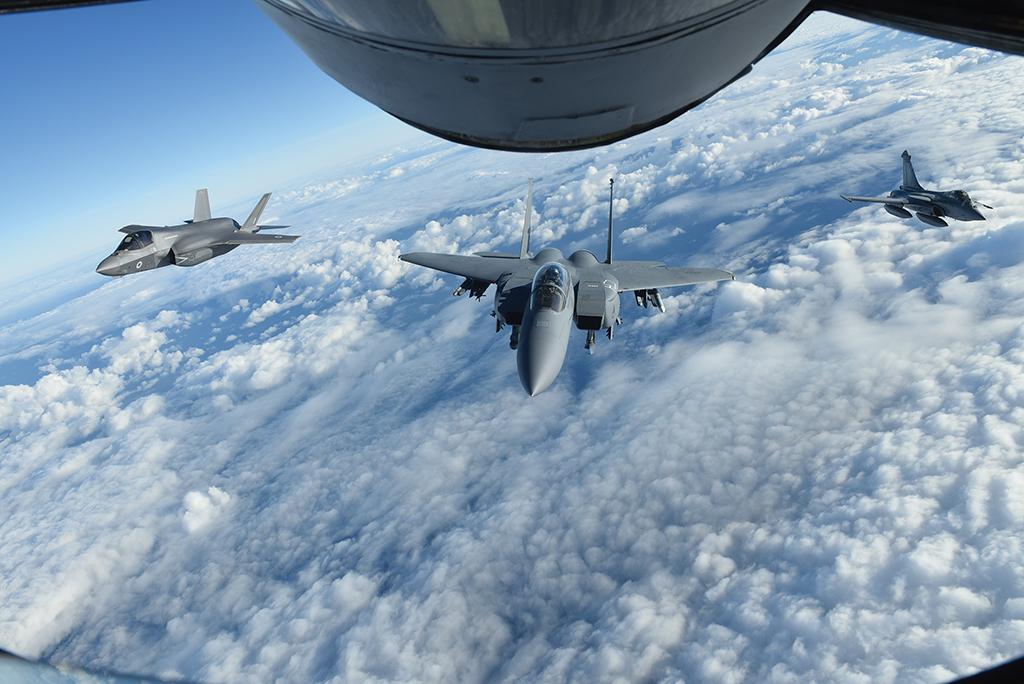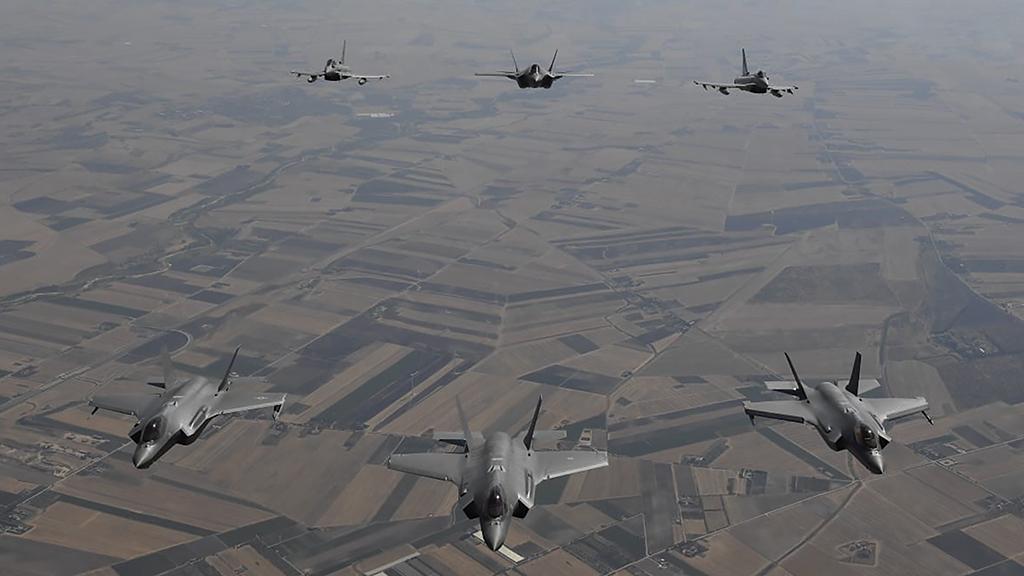
Fateful decisions loom in the next 12 months for a global fighter market caught up in a pivotal debate over how much to invest in each of three generations of aircraft designs now in production or development.
As next-generation fighters continue to take shape on industry drawing boards—and in one case, a secret flying demonstrator—a final decision in 2021 over whether to buy another batch of aircraft with a Cold War legacy or Lockheed Martin’s 20-year-old-design F-35A stealth fighter confronts Canada, Finland, Israel, Switzerland and, perhaps most surprisingly, the U.S.
-
Internal U.S. Air Force fighter road map capped the F-35 at 1,050
-
Canada, Finland and Switzerland contract awards expected in 2021
With 13 purpose-built fighter types now in production globally for export customers (excluding about half as many modified training jets), military buyers are spoiled with competitive options and motivated sellers. But a series of contract awards planned for the next 12 months could induce a long-awaited reckoning, especially among production lines for fighters produced in Europe and the U.S.
Multiple decisions in favor of so-called fifth-generation capabilities could nearly complete the F-35’s dominance over European and American fighter demand for the next decade. Alternatively, if the balance of new contracts falls to fourth-generation rivals, the F-35 is likely to continue to face intense competition from the same aircraft it was designed to replace.
For now, pressure from F-35 competitors is surging, including from within the type’s biggest customer. The U.S. Air Force’s program of record for the F-35A stands at 1,763 total aircraft, a figure that has not budged in nearly two decades, despite changes to the assumptions that determined the original number.
The pressure on the Air Force’s orderbook for F-35As has been building for at least six years. Speaking on condition of anonymity in November 2014, a senior Air Force official said the service internally was considering a purchase of 72 new Boeing F-15s, Lockheed Martin F-16s or even the Navy’s Boeing F/A-18E/Fs. Hindsight suggests the disclosure may have been intended as a negotiating ploy with Lockheed over F-35 prices, but the idea clearly never died.
Indeed, the Air Force signed an order in July 2020 for the first eight of “at least” 144 Boeing F-15EXs, replacing an aging fleet of F-15C/Ds.

By 2018, those F-15C/Ds already had outlived their original service-life estimates as victims of the Defense Department’s decision in 2010 to truncate production of the Lockheed F-22 after 185 deliveries. With only a longeron replacement necessary to maintain structural integrity, the Air Force still was planning to keep the F-15 C/D fleet in service for at least another decade until a next-generation fighter became available. But then the Air Force discovered another major structural flaw: The entire fleet required new wing skins to remain airworthy.
Rather than invest in a major structural refit, the Air Force announced plans in 2019 to retire the fleet. But the manner of the F-15C/D replacement plan came as a shock. Breaking from a two-decade-old strategy to buy only stealthy fighters, the Air Force decided to bypass the F-35A and order F-15EXs instead.
With cockpit, flight-control and wing upgrades mostly funded by Qatar and Saudi Arabia, the Air Force developed a new, long-term role for a fourth-generation fighter.
Such a role already had been envisioned behind closed doors by a new organization on the Air Staff. Created in January 2018 as an internal think tank, the Air Force Warfighting Integrating Capability (AFWIC) office had torn up the long-standing assumption that only stealthy fighters could perform a useful role.
By the end of 2018, the AFWIC’s team of analysts had adopted a new fighter road map, according to a source. The road map envisioned a “great power” war. The principal role for each F-35A was to launch two stealthy cruise missiles—Lockheed AGM-158 Joint Air-to-Surface Standoff Missiles (JASSM)—from just inside defended airspace. That “kick-down-the-door” pairing would be combined with mass launches of multiple JASSMs each from F-15Es and F-15EXs, the source said. Other missions—namely, defensive counter-air and homeland defense—could be performed by the F-35. But other aircraft such as F-15EXs and F-16s also could be used.
Driven by this new appreciation for a portfolio of fighter capabilities, the AFWIC team also reconsidered how many of each type would be needed. No fighter program escaped scrutiny, including the long-standing Air Force commitment to acquire 1,763 F-35As. AFWIC’s fighter road map by the end of 2018 had capped F-35A deliveries at about 1,050 jets, the source said.
Although that cap implies a 40% cut to the original plan for the F-35A, no change to the program of record was necessary, the source said. The Air Force has ordered 451 F-35As so far, according to the Aviation Week Network Military Fleet database. If new aircraft orders are maintained at a rate of 2-2.5 squadrons a year—48-60 jets—for the foreseeable future, the Air Force is at least 10 years away from hitting the 1,050 cap in AFWIC’s fighter road map.
In the meantime, the Air Force faces other decisions about whether to invest in more fourth-generation fighters, F-35As or next-generation aircraft. The Air Force still operates 232 Block 25 and Block 30 F-16C/D jets, which were delivered in the mid-1980s, according to the Military Fleet database. Air Force officials have said they expect to make a fleet replacement decision for these so-called “pre-block” F-16s in 4-7 years.
When the Air Force established the program of record for buying 1,763 F-35As, the plan assumed replacing all of those pre-block F-16s. As a replacement decision enters the Pentagon’s five-year budgeting horizon, however, Air Force officials have been more flexible. Last February, the head of Air Combat Command, who was then Gen. Mike Holmes, said low-cost, attritable aircraft would be considered for the pre-block F-16 replacement in the 2024-27 time frame.
The fighter road map completed by AFWIC in 2018 considered the F-16 Block 70/72 and a potential fighter version of the Boeing T-7 as candidates for light-fighter sales to foreign militaries, the source said.
“The trade space in the fighter road map is real, and the trade space is a combination of payload, range, speed and survivability,” the source said. “And I don’t need all of one thing. I need a portfolio of things.”
Over the past decade, the same debate has raged within the air forces of other countries, particularly for those that cannot afford to operate more than one type of fighter. The F-35 has fared well in those decisions. Among countries that have been offered the F-35, only Germany has rejected the stealth-fighter option so far.
That record will be put to the test next year against a backdrop of national economic pressures imposed by the costs of the COVID-19 pandemic. Switzerland, Finland and Canada are evaluating proposals.
A year-long political crisis in Israel delayed plans to order either F-15EXs or more F-35As, or both. A resolution to the country’s presidential election was not reached until after the COVID-19 pandemic arrived in Israel, to consume the attention of decision-makers.
In other countries with a fighter aircraft-design capability, the debate over spending on tactical aviation includes a third dimension. Following several years of study and analysis, the next generation of designs is beginning to assume a tangible form.
This is especially true in the U.S. defense industry. In a startling, mid-September announcement, Will Roper—assistant secretary of the Air Force for acquisition, technology and logistics—declared the service had developed, built and flown a flight demonstrator for the Next-Generation Air Dominance (NGAD) program. Roper’s announcement was light on details, including the time frame of the flight, details of the aircraft design and the status of the program now.
But the concept of the need for an NGAD flight demonstrator was suggested in September 2019 by Gen. David Goldfein, who was then chief of staff of the Air Force.

Several months before, the Air Force released a five-year budget plan that included a $6.6 billion funding cut for the NGAD program, a roughly 50% reduction compared to spending levels over the same period from only a year before. The spending cut made it unclear what had become of a notional concept popularized in 2015 and 2016 by U.S. defense contractors of a “sixth-generation fighter,” featuring a supersonic aircraft design lacking vertical tails and carrying advanced weapons such as an embedded high-energy laser for shooting down incoming missiles.
Instead, the Air Force’s leaner spending plan for the NGAD in 2019 supported a different concept for a next-generation fighter. Rather than a standalone aircraft that could, much like the F-35 and F-22 design requirement, prosecute a mission by itself with a diverse array of sensors to detect and identify targets in the air or on the ground in any weather, along with all of the munitions necessary to destroy those targets, the Air Force increasingly has emphasized adopting a family of systems to “close the kill chain.” The sensing and munition capabilities would be distributed among multiple aircraft that often must collaborate to complete a mission.
At the same time, the Air Force is investing in several new technologies related to air dominance. A Next-Generation Adaptive Propulsion program aims to deliver an advanced new turbofan engine in fiscal 2025, with GE Aviation and Pratt & Whitney developing rival designs. A new family of unmanned aircraft systems designed to augment or operate independently of crewed fighters is being developed under the Air Force Research Laboratory’s Skyborg program.
In his remarks in September 2019, Goldfein said the NGAD program now is focused on maturing five different technologies that the Air Force does not intend will come together on a single platform. A prototype aircraft, he said, was necessary to demonstrate those technologies in flight.
In Europe, progress is being made toward a next-generation fighter. By August 2021, France, Germany and Spain expect to conclude Phase 1A of the Future Combat Air System (FCAS) demonstrator program, with the goal of defining a wide range of technologies that will be carried into a flight demonstration scheduled to begin under Phase 1B at the end of 2026.
A collaboration among the UK, Sweden and Italy under the Team Tempest consortium will enter 2021 with renewed support. A long-awaited defense review in London finally was published in November showing support for the Future Combat Air System Technology Initiative under a £1.5 billion ($2 billion) fund for military research over the next four years.
Tens of billions more will be needed to complete development of the NGAD, FCAS and Tempest over the next two decades, even as Western governments continue to split modernization investments among three fourth-generation fighters—the Dassault Rafale, Eurofighter and Saab JAS 39E/F Gripen—and the F-35. Maintaining the right balance of spending in each category will consume the debate over fighter aircraft decisions on the horizon.


Comments
Sensor fusion from cheaper sensors/electronics have diminished the stealth advantage.
1) the political/ideological stance of the purchaser, this limits what will be offered, e.g. F-16/F-35.
2) the initial purchase price and any offset agreements available, also technology transfer deals.
3) cost per flight hour and reliable long term support, spending billions on a fighter fleet and having your spares supply cut off because you use them is irritating!